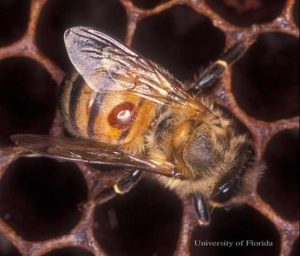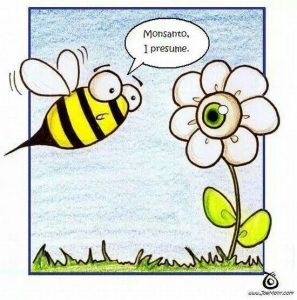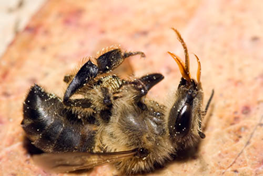and so I was busy freezing my rhubarb stalks with sugary plans ahead … the final trick to powdering it is to FREEZE it after dehydration and then chopping it up in a blender. Add to the confectioner sugar and do the normal sugar treatment. I DO realize that this will do nothing for drones or worker bees in the sealed brood but it is a start.

Varroa Mite
1. Last year a hive I had in Carlsborg was killed off by a friend hanging a yellow jacket trap directly over the hive entrance. By the time I found out (weeks later) there was not much left of the hive. NEVER put a yellow jacket trap near a bee hive as it will attract more to attack the hive.

2,4,5-T a popular and toxic weed killer WAS finally phased out in the U.S. in the 1970s amid toxicity concerns, but many of these replacements are equally harmful. We simply no longer have an EPA that cares or is not bought off by the chemical industry and their lobbyists, if indeed their former CEO’s are not on the cabinet level in the recent administrations.
Neither does Toxipedia have much to say about bees and weed killers. Some like Picloram don’t even get a listing – depends what weed killer you are using as to what information is around). States also have different laws and regulations. 
Best I could come up with is that: “Population-level effects on honeybees may occur even if a pesticide has low acute toxicity. For example, certain pesticides interfere with honeybee reproduction, ability to navigate, or temperature regulation, any of which can have an effect on long-term survival of honeybee colonies. The neonicotinoids, pyrethroids and keto-enol pesticides are some types of pesticides causing one or more of these effects”.
All said, would you BUY the honey from a hive that harvests from sprayed dandelion or clover? So all is up the xxxx creek when it comes to labels on herbicides. Mostly, the literature says it doesn’t look dire. Not great either.
Even more appalling is that the half-life time of some of these herbicides/pesticides (think of your young dogs, pets or toddlers on a lawn) is close to 40 days. Personally, I would not walk barefoot on such a lawn or landscape barefoot for TWICE the half-life time … so some 80 days.
So it takes quite a while. (the half life is the time it takes for half the product to be gone, in the soil in this case). Which also leads to the population decline of soil organisms, worms and other beneficial microorganisms.
ROUNDUP is a classic example: Popular and paraded as safe, it is used by farmers, forestry and homeowners alike, in fields, lawns and gardens. Many studies claim that Roundup is safe and environmentally friendly.
However, other European studies link Roundup to health issues like cancer. At the very least there are hundreds of different types of microorganisms in your gut, most of which are bacteria. I believe it certainly can affect your own microflora and do a number on your friendly gut bacteria. I have observed many users come down with diarrhea or short flu like conditions after using it. I do not think that is the worst it does to you.

Further, as it is with the labeling of all ingredients it is often the .5 OTHER that you need to worry about. Near all these herbicides can carry traces of Dioxin. TCDD
Of course the present EPA says that none occurs anymore. HA! Their labeling also shows a softening of language. This stuff is safe. So is roundup.
EPA: “2,4-D generally has moderate toxicity to birds and mammals, is slightly toxic to fish and aquatic invertebrates, and is practically nontoxic to honeybees.”
The French seem to disagree as do many European countries. I trust them a lot more than our own EPA.

Be it India, Bhopal or other nations, our media and agencies suggest all is well and safe. But, ‘Collateral Damage’ isn’t always going to happen thousands of miles away. This crap and more is made locally, in Louisiana and in many of our states. Disposal of waste products is also questionable done … unless it is exported out.
Much easier to simply find a hidden swamp or holler and dump it there, as we found out locally with a logging company dump still not cleaned up decades later.
FOOTNOTE:
Any time you find a pile of dead bees on the OUTSIDE of the hive indicates an event other than CCD or a mite problem. Those bees normally will be found on the inside of the bottom board or have been carried away. A pile outside the hive usually is a case of poisoning, and looking at their tongues sticking out usually is a dead giveaway. Sorry about that.
A poisoned hive usually will show a massive dump of bees all at once and the dead bees will have their tongues extended.
It often is timed or systemic poisons that do bees in. These may be in the all purpose ROSE control products or time release lawn killers for lawn grubs. Most beekeepers will never be able to determine the source as bees will forage for miles. One may actually find one hive succumbing while others are fine. Simply the luck of the draw. The hives scouts did the hive in and they were feeding on a poison source much greater than the others.
So please do not ask me why bees are declining. It is because of your use of crap poisons such as Momentum … another nicely hyped product. “It is a systemic herbicide that kills many species of garden plants and flowers but does not harm grass.”
I just pray that someday this Western obsession for the vampire lawn dies!!!

ON CAPTURED SWARMS:
QUESTION:
Usually I give them a week. Just as with humans, they may not like their housing decision made for them and will be looking for any reason to leave. Put in a pollen patty and feed some sugar water to give them incentive to stay. They may NOT be bringing in pollen at first but if they are out actively foraging be happy. And patient!!! [U] A young queen from a package install failure, may actually still be going out to do some mating.[/U]
One basic overenthusiastic mistake new beekeepers do is ripping the roof off their heads just as they are beginning to do their first housekeeping, cleaning up old foundation or putting in new. Depending upon temperament and nectar resources they may simply refuel and take off again.
Two weeks allows them to start building comb and the queen can begin populating the hive once again.
That said, I do one QUICK treatment and that is a basic confectioners sugar dust (30 seconds to do) . Reason being, if they are from an established hive they may be dragging Varroa mites along. Doing this treatment on a weekly basis until brood occurs may be useful.
I also add a few drops of essential oils, thyme and mints to this sugar. Cannot hurt unless you overdose. Also, for fun and an experiment I am trying (natural oxalic acid) from rhubarbs.
I dehydrate the stalks till they are hard, then FREEZE and then pulverize in a blender with regular sugar. This when powdered I add to my standing sealed jar of confectioner sugar.
NOPE. No basis, no study but I have been able to keep my hives going without other treatments. Also bringing in new hygienic stock to refresh or building up your own is a big element in this. So are open screened bottom boards.
On a bee forum I replied to the amazing chutzpa of a 68 acre produce farm that put out an add for beehives to be put on his land in exchange for him getting a couple of gallons of honey.
Either he is naïve enough to believe that beekeepers get 200 lbs. of disposable honey every year and that his produce would even contribute much aside from potential herbicide/pesticide risk to the beekeeper.
I pointed out that “produce farms” often are sprayed more regularly than orchards containing fruit trees.
Even “healthy” garlic fields often had pre-emergent soil fumigations as did strawberries. Drive through the central valley of CA in the Spring and Summer and you cannot get the smell out of your car.
The most heavily sprayed major crops are the following. Something every beekeeper should be aware of. Add surrounding farms near the apiary site and your bees might be harvesting from them as well. Contaminated pollen and nectar are the price we have to bear. That said, urban sites often are even more at risk as any visit to a Costco and Home Depot will attest. The soil sterilant’s and lawn herbicides simply reek and home owners often are far more negligent in application than any cost conservative farmer would be.
My own personal experience deals with local neighbors who continued to spray their lawns on a weekly basis despite wind issues blowing the stuff across the road. Mind you, that is only ONE of the local neighbors.
I am no longer surprised at all to a loss of bees due to pesticide contamination.
In order of chemical spraying the following are the top ten crops one should be aware of.
Strawberries
Spinach
Kale, collard and mustard greens
Nectarines
Apples
Grapes
Cherries
Peaches
Pears
Bell and hot peppers
Tomatoes
Celery